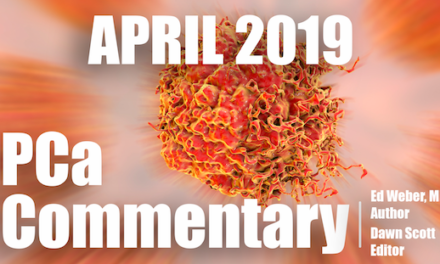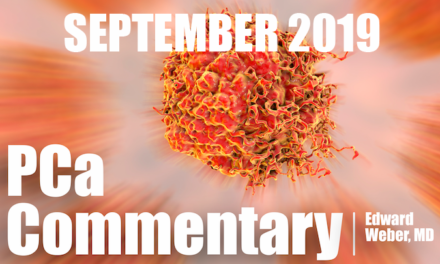
PCa Commentary | Volume 132 – March 2019
Posted by Edward Weber | March 2019
Resistance to Therapeutic Agents Targeting the Androgen Receptor and Insights into Sequencing Treatments for Optimal Outcomes
Ever since the first orchiectomy for metastatic prostate cancer in 1941, researchers and clinicians have been determinedly trying to restrain the androgen receptor (AR) by manipulating its hormone environment. But like Houdini, after initial suppression this wily adversary wriggles a bit and then escapes — transitioning prostate cancer into a castration-resistant state. Alterations in the AR eventually frustrate the beneficial gains from LHRH inhibitors and anti-androgens like Zytiga, Xtandi, Erleada, etc. This escape is accomplished by a variety of different mechanisms, presenting the challenge of anticipating and circumventing the persistence of AR signaling.
Mechanisms of resistance:
The androgen receptor is the principal driver of castration-resistant prostate cancer (CRPC). Alterations in this pivotal signaling protein are the primary source of resistance to drugs used to suppress its function. The various mechanisms include the following:
- an increase in the number of AR gene copies (‘amplification’)
- development of point mutations (i.e., changing the AR ligand binding pocket to allow stimulation by other steroids, such as glucocorticoids and progesterone)
- increased expression of variant AR forms (i.e., AR-V7 and family that are self-stimulating independent of androgens)
- synthesis of intraprostatic androgens from adrenally-sourced dehydroepiandrosterone (DHEA)
- overexpression of the enzyme inhibited by abiraterone (CYP17A)
- transdifferentiation to neuroendocrine cancer
Signals from the tumor microenvironment (TME) influence AR alterations and contribute to the development of resistance. Microenvironmental elements like collagen matrix, fibroblasts, tumor infiltrating lymphocytes, and myeloid-derived cells, all which lie in close proximity to the tumor, respond to depressed androgen levels and alter the cancer cell genome.
One recognized consequence from this interaction is activation of the ‘epithelial mesenchymal transition’ (EMT), which leads to CRPC and promotes cancer aggressiveness, invasion, and metastases.
Recent studies have shown that signals (i.e. a cytokine, IL-23) arising from myeloid-derived suppressor cells in the microenvironment of the diminished androgen state activate the AR pathway and promote cell survival and resistance (in this study, resistance to enzalutamide). Undergoing research are anti-bodies to IL-23 that could restore enzalutamide’s effectiveness (Calcinotto et al., Nature, July 2018.)
Taken together, these factors comprise the basis of eventual resistance to drugs commonly employed in order to control the progression of prostate cancer.
The primary concern:
As challenging as these subjects are for research, the practical concern for prostate cancer patients is whether this information can be applied to improve treatment outcomes: prolongation of progression-free, metastases-free, and overall survival.
Managing the adverse mutations in the androgen receptor:
- Research has shown that during therapy, the AR adapts to a low androgen environment by generating mutations that predispose to castration resistance. This raises the very basic issue as to when to institute androgen depression in the face of a rising PSA after primary treatment. Spratt et.al., ASCO.org/edbook, 2018, cited three studies showing no benefit in overall or cancer-specific survival for immediate ADT (within 2 months after biochemical recurrence) except in instances of a rapid (<6 – 9 months) PSA doubling time, which is associated the early development of metastases.
- As a generalization, a good response to hormone suppression is unlikely when the PSA doubling time < 12 months. Recent studies have shown that men in that category are better candidates for combined therapy with an LHRH inhibitor and one of the newer agents, i.e. abiraterone, apalutamide or enzalutamide
-
Resistance to abiraterone (‘Zytiga’) and enzalutamide (’Xtandi’):
- About one third of men are resistant to both of these drugs at first exposure. Therapy with both agents over time induces the overexpression of the AR splice variant AR-V7 — a major source of resistance. Antonarakis et al., NEJM, 2014 Sept, demonstrated that when circulating tumor cells in men with metastatic disease tested positive for AR-V7, none of the patients responded to either agent. (Other studies report infrequent responses.) A study by Scher et al. (JAMA Oncology. 2016 June) found that docetaxel retains effectiveness when confronting AR-V7 overexpression.
- Taken together, this data suggests that after the failure of either drug, and before instituting the alternative, a blood test for AR-V7 can provide guidance in the choice of the next treatment.
- The AR-V7 assay is available commercially at Quigen (AdnaTest ProstatePanel AR-V7) and with OncotypeDx’s Nuclear Detect test, and continues to be offered at Johns Hopkins.
-
Sequencing: Enzalutamide or abiraterone as 1st line therapy in CRPC?
- After progression to CRPC, the frequently arising decision is which drug, abiraterone (AA) or enzalutamide (ENZ), provides the better initial outcome. This issue was addressed at ASCO June 2017: “A randomized phase II cross-over study of abiraterone + prednisone vs enzalutamide for patients [202] with castration-resistant prostate cancer”, Mattie Annala et al., clinical trial NCT02125357. The primary endpoints of the study were the response rate to the first drug and the time to progression after 2nd-line therapy. The study patients had metastases to bone, liver and lung in 83%, 6%, and 10%, respectively.
- Findings: First line ENZ showed a PSA of >50% at 12 weeks of 77% vs 55% for AA. Because of the study’s small size, the difference in the median time to PSA progression on 1st line ENZ (14.9 months) vs 1st-line AA (10.2 months) was statistically insignificant. Following either drug as 2nd-line, the median time to progression was 7.4 months for both drugs. Among all the patients,10% to 20% showed no response to either drug.
- “Not surprisingly, circulating tumor DNA biomarkers suggest the patients with TP53 and BRCA2 alterations identify patients with a poor prognosis.”
-
Steroid switch – prednisone to decadron upon AA/prednisone failure:
- A Phase II pilot study (Romero-Laorden et. al., British Journal of Cancer, 2018 Aug) reported that of 26 men with metastatic CRPC progressing on abiraterone/prednisone, when switched to a regimen of abiraterone/decadron (0.5 mg/day), 46.2 % showed a >30% drop in PSA and in 34.6% the PSA declined > 50% (as tested at 12 weeks). “Median time to biochemical and radiographic progression was 5.3 and 11.8 months respectively.” No man whose circulating tumor cells showed a gain in AR copy numbers responded.
-
Is there an enzalutamide withdrawal response after initial benefit?
- Enzalutamide over time can induce a conformational change in its target, the ligand pocket of the AR, and activate the AR as opposed to inhibiting it. However, the PSA ‘withdrawal’ response to stopping ENZ is insignificant, as opposed to up to ~30% of men who show a clinically meaningful PSA response upon the withdrawal of bicalutamide after initially responding to the drug
-
Recapture of enzalutamide effectiveness with the BAT regimen:
- The ‘BAT’ (bipolar androgen therapy) trial studied 30 asymptomatic men with metastatic CRPC who showed progression on enzalutamide. The BAT regimen employs intramuscular testosterone cypionate, 400 mg every 28 days (yielding supraphysiological T levels of ~1500 ng/dL) while continuing LHRH suppression (ADT). A median of 6 cycles were administered (range 1- 26). Lancet Oncology Teply et al., Jan 2018, reported that 30% of men (9/30) responded with a 50% decline in PSA. Upon rechallenge with ENZ, 52% (11/21) achieved a PSA 50% response, suggesting that the BAT regimen can resensitize the AR to re-exposure to ENZ. BAT was considered safe — 3% of men experienced significant side effects. “These data represent the final analysis for the post-enzalutamide cohort, while two additional cohorts (post-abiraterone and newly castration-resistant prostate cancer) are ongoing.”(NCT02090114)
-
Darolutamide, another anti-androgen, joins the team — Does it offer features not available with enzalutamide or apalutamide?
- On February 14th, the NEJM published the results of the randomized phase 3 trial, “Darolutamide in Nonmetastatic, Castration-Resistant Prostate Cancer.” (Fizazi et al). Eligibility required a PSA doubling time of less than 10 months (the median was 4.4 months), the same requirement as in the studies of apalutamide and enzalutamide when tested in the nonmetastatic setting. Metastasis-free survival was the endpoint in all of the trials of three agents: for darolutamide, 40.4 months; for enzalutamide, 36.6 months; and for apalutamide, 40.5 months.
- Adverse events were also quite similar in kind and frequency in these three trials — all about 25%. The orally administered darolutamide was associated with fatigue in 11.4%; hypertension, 5.2%; cognitive disorders, 0.2%; and seizures, 0.2%. Fatigue – up to 15%, has been a common adverse event for all three agents. Only a head-to-head comparison of these drugs will provide detailed data about the effectiveness and side effects of these treatments.
-
A heads-up toward the future:
- In early 2019, a phase I clinical trial will test a new drug, ARV-110, which employs a markedly different approach to suppressing the AR — its total destruction. A small molecule, orally administered, has been crafted to attach to the AR protein and tag it for on-site degradation. Preclinical studies have suggested it is effective against AR mutants and AR overexpression; as well as in mice resistant to enzalutamide. The drug has been cleared by the FDA for Phase I testing.
BOTTOM LINE:
Resistance to androgen receptor-targeted therapies regularly develops during therapy. The mechanisms underlying this resistance are varied. Research is ongoing in an effort to devise regimens to counter this liability.
Your comments and requests for information on a specific topic are welcome e-mail ecweber@nwlink.com.
Please also visit https://prostatecancerfree.org/prostate-cancer-news for a selection of past issues of the PCa Commentary covering a variety of topics.
“I want to thank Dawn Scott, Staffperson, Tumor Institute Radiation Oncology Group, & Mike Scully, Librarian, Swedish Medical Center for their unfailing, timely, and resourceful support of the Commentary project. Without their help this Commentary would not be possible.”
ABOUT THE AUTHOR
Edward Weber, MD, is a retired medical oncologist living in Seattle, Washington. He was born and raised in a suburb of Reading, Pennsylvania. After graduating from Princeton University in 1956 with a BA in History, Dr. Weber attended medical school at the University of Pennsylvania. His internship training took place at the University of Vermont in Burlington.
A tour of service as a Naval Flight Surgeon positioned him on Whidbey Island, Washington, and this introduction to the Pacific Northwest ultimately proved irresistible. Following naval service, he received postgraduate training in internal medicine in Philadelphia at the Pennsylvania Hospital and then pursued a fellowship in hematology and oncology at the University of Washington.
His career in medical oncology was at the Tumor Institute of the Swedish Hospital in Seattle where his practice focused largely on the treatment of patients experiencing lung, breast, colon, and genitourinary cancer and malignant lymphoma.
Toward the end of his career, he developed a particular concentration on the treatment of prostate cancer. Since retirement in 2002, he has authored the PCa Commentary, published by the Prostate Cancer Treatment Research Foundation, an analysis of new developments in the prostate cancer field with essays discussing and evaluating treatment management options in this disease. He is a regular speaker at various prostate cancer support groups around Seattle.




